|
As a long-standing fan of old-school Hong Kong martial arts movies, it seems insane that in almost two decades of writing for Cine Outsider, I’ve never really talked in any detail about Sammo Hung, or to give him his full name, Sammo Kam-Bo Hung. It’s not that I haven’t had the chance, mind you. Previous opportunities to do so have been presented by Eureka in the shape of its Blu-ray releases of Three Films with Sammo Hung in 2019, The Lucky Stars 3-Film Collection in 2020, and Encounter of the Spooky Kind and Millionaires’ Express in 2021. Yet somehow, personal or work-related issues got in the way of me covering every one of these releases, and you could almost suspect from this that I had a grudge against Sammo or disliked his movies, which genuinely couldn’t be further from the truth. Although he made his mark on the martial arts movie scene in the years immediately following the ones that so bewitched my teenage self, once I was finally introduced to his work, I quickly became a fan.
The Peking Opera-trained Sammo Hung is a man of many and remarkable talents and some distinctive character traits, but let’s get the most obvious one out of the way first. Unlike his lithe and muscular contemporaries and forebears such as Bruce Lee, Jackie Chan, Yuen Biao, Jimmy Wang Yu and almost any other that you care to name, Hung is, and seemingly always was, on the large side. His is the sort of body that physical fitness trainers like to tell you is desperately in need of a heathy diet and exercise, and not one you’d naturally think would lend itself the fast and furious movements that are the core of any decent martial arts movie. Yet Sammo is one of the fastest, most flexible and most acrobatic performers in the genre, a man whose grace of movement and energy I never came close to matching even at my high-exercise fittest. It’s his large frame that makes his ability to execute a perfect headspring or a blizzard of fight moves whilst ducking and diving under and over swung weapons, fists and legs so awe-inspiring – he’s a running, fighting, leaping and tumbling challenge to the commonly held perception of what such a body shape implies. But there’s more. Having quickly established himself as a talented fight choreographer, in 1977 he also began his career as one of the genre’s most respected directors with The Iron-Fisted Monk, one of the first films to mix martial arts with comedy. It’s a subgenre that would prove fertile ground for Sammo, who seemed to miss no opportunity to find comedic value in his large frame, which hit something of a peak in the 1990 Skinny Tiger and Fatty Dragon (also coming to Eureka Blu-ray in February). No prizes for guessing which of those two characters he played.
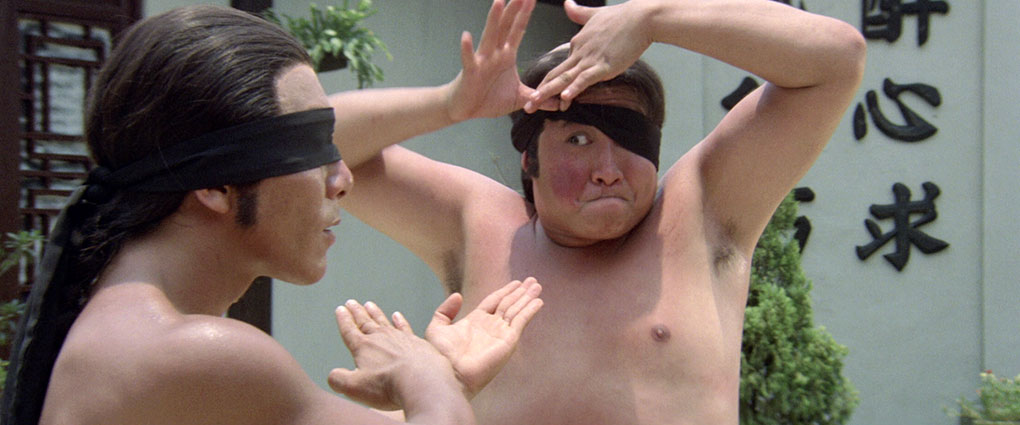
It was in the late 1970s and early 80s that Sammo really began to flourish, and this 2-disc Blu-ray consists of two of the his finest films from that period. They are linked by their showcasing of the Wing Chun fighting style, which has been more recently popularised by the Ip Man series, which chronicles (and partially fictionalises) the early life of Wing Chun’s most celebrated grandmaster and teacher, Yip Man, whose student, Bruce Lee, used Wing Chun as the basis for his own fighting style, Jeet Kun Do. Both films are centred around the true life character of Leung Tsan, but chronologically they were made in reverse order. In Warriors Two, Tsan is portrayed as a middle-aged Wing Chun sifu by the then 29 year-old Bryan Leung Kar-Yan, whereas in The Prodigal Son, he’s played as an initially cocky young man by rising star Yuen Biao. Both films are regarded as genre classics by connoisseurs, and both showcase Sammo’s talent as a director, an action choreographer and performer at close to his best.
| WARRIORS TWO [ZAN XIAN SHENG YU ZHAO QIAN HUA] (1978) |
|
It’s not uncommon in 70s martial arts cinema to encounter a title sequence in which the lead character demonstrates his skills as the credits unfold, usually against a single-coloured background, a taste of things to come to tide you over while the principal characters and storyline are established. In Warriors Two, the setting for this sequence is a bamboo forest in which two figures – Wing Chun master Leung Tsan (Bryan Leung Kar-Yan) and a younger man known by his profession as Change-Giver Wah (Casanova Wong) – are sparring. Both are clearly skilled, Tsan more so, and as they do battle, a narrator tells us a little about the history of the Wing Chun style.
Despite Hung’s reputation for lacing action with comedy, this suggests that Warriors Two is going to play it straight. It’s a perception quickly shattered when the title sequence concludes and we’re introduced to Fat Chun (Sammo Hung, sporting a rather peculiar take on the tradition Quin shaved forehead and hair plat), a Foshan City market vendor who’s having little luck selling rice dumplings that he tends to end up eating. When he’s swindled out of his wares by two local con-men – one of whom is saddled with a particularly daffy set of false goofy teeth – he is advised by the above-mentioned Change-Giver Wah to choose a profession whose wares he will not eat and that others will not steal, so switches to transporting the contents of toilets to wherever it is the crap-carriers of the day used to dispose of such material.
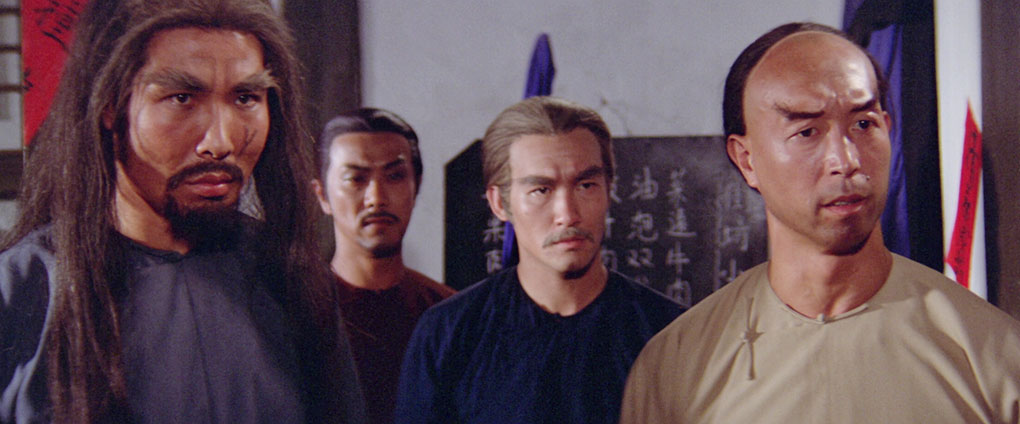
Elsewhere in town, a group consisting of three fighters – Manchu Chiu (Lee Hoi Sang Lee), Tiger Ha (Yeung Wai) and Thunder Tai (Tiger Yang) – and their four henchmen enter a local tea house, which in martial arts movies always seems to be a prelude to trouble. We’ve already been given good reason to regard these three as bad guys when they stopped to rudely demand directions from Chun, while the fact that Thunder Tai has long straggly hair and a scar on his face is a genre-favourite indicator that he’s probably a nasty bastard. Confirmation that the men are up to no good comes when the four henchmen occupy a table that the proprietor politely informs them has been booked by Leung Tsan, to which they respond by slapping the poor man across the face. It’s at that very moment that Tsan arrives with his niece, Gam Fung (Christina Cheung Man), whom the henchmen insult and who promptly dishes out a couple of sound slaps of her own. At this point, the three fighters verbally intervene, but the diplomatic Tsan elects to leave before a serious physical confrontation takes place, and the expected battle thus does not unfold after all. I, for one, was genuinely surprised.
It turns out that the men are in town to lend their help to their former gang leader, Boss Mok (Fung Hak-On), a now successful banker whose ambition is to rule the whole of Foshan as its mayor. The only thing standing in his way is incumbent mayor (Choe Mu-Ung) and his bodyguard (Lau Kar-wing), and it would make things considerably easier for Mok if these two were to suffer a fatal accident at the hands of the visiting fighters. Unfortunately for them, their plan is overhead by Change-Giver Wah, who attempts to alert the mayor to this plot against him, unaware that his assistant, Advisor Yau (a comically peculiar performance by Dean Shek Tin, who apparently specialised in roles of this type), is secretly in league with Mok.
It’s a busy opening 15 minutes of plot building and character introduction that lays the groundwork for the fights to come. The first occurs when Wah is lured into a trap and has to single-handedly fight all seven of the men in Mok’s gang, and it’s an absolute blinder. The fight choreography and staging are superb, a mixture of one-on-one unnarmed combat and a brief but blistering battle in which Wah takes on all four sword-wielding henchmen at once. Wong is amazing here, particularly his skill as a kick-boxer, which sees him deliver seven consecutive high kicks without lowering his leg once. I watched the film three times in the course of writing this review, but I’ve rerun this sequence more times than I can count. By chance, the seriously injured Wah escapes and stumbles into Chun, who eludes the pursuing gang and carries his friend to Tsan’s clinic for medical assistance, in the process tying all of the story strands together. Chun then acts on the weakened Wah’s request and tries to warn the mayor, who dismisses his concerns and is ambushed by Mok’s gang in the film’s second showpiece fight, which matches the standard set by its predecessor and runs for three times its length. It’s brought to an end by a kick so violent that it sent me scurrying to the film’s IMDb trivia page to check if there was any mention of a stuntman being seriously maimed or killed.
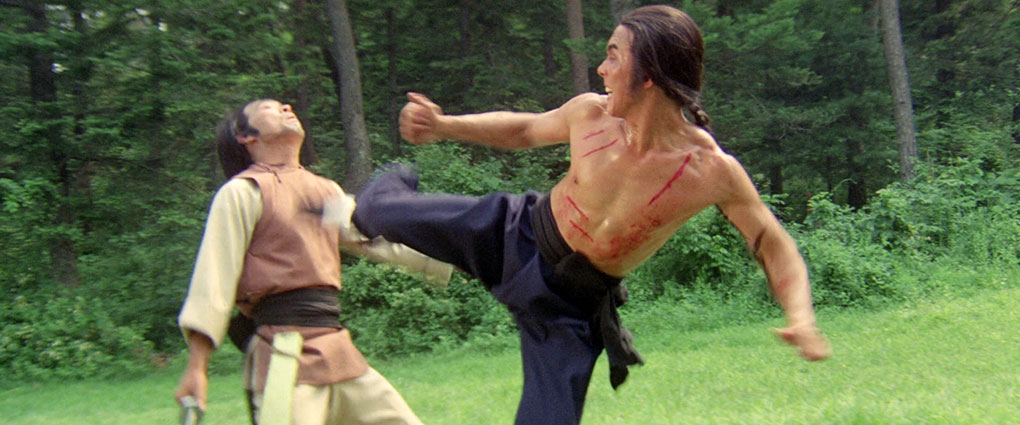
Training sequences are a favourite component of many a martial arts movie, but the one in Warriors Two is one of the best and – unexpectedly – most educational. It begins when Chun employs unorthodox means to convince his initially reluctant master Tsan to also take Wah on as a student, and when he finally does, his training lasts far longer than the montage-driven norm (it occupies almost 20 minutes of screen time in total), but it also acts as an instructional film in some of the techniques and philosophies of the Wing Chun fighting style. Highlights include a training bout between Wah and Chun in which they are both blindfolded, and a training room in which Wah has to do battle with two mechanically operated Muk Yan Jong wooden practice dummies, the sort of contraption you sometimes find in period martial arts movies but that you know never existed at this time and place.
As is often the way with Sammo Hung films, the plot proves to be more than just a vehicle to transport the characters from one fight to the next, even if it does prove to be primarily about providing justification for future conflict. In pursuit of that goal, however, it takes a couple of unexpected twists that I’m not about to spoil here, one of which even moves the story into the realms of tragedy. It’s also bloodier than a good many of the genre films of the day, and the use of an animal trap to further incapacitate one already hopelessly outnumbered individual – together with the later casual dumping of his body in front of his comrades – really cements the bad guys here as irredeemable and in need of the some of the biggest of Wing Chun slaps that Tsan and his companions can deliver.
Of course, the story still proves secondary to the fight scenes that are any martial arts film’s true raison d’être, and the ones here are some of the best you’re likely to see all year. As ever, the camera is slightly undercranked to subtly accelerate the performers’ speed of movement, but the complex choreography and the blistering performance of whole sequences of perfectly executed and sometimes breathtakingly acrobatic moves makes every battle thrilling to watch. Wong, who never became the genre star his work in this film suggests he was destined to be, is especially impressive here, combining close-quarters Wing Chun moves with his own spetacular Tae Kwon Do kicks to visually dazzling effect. It’s no surprise that the astonishing late film flying kick he delivers by leaping over a table whilst spinning 360 degrees in the air is the climactic shot of both trailers on this disc, one of a carefully selected handful of slow motion shots used to emphasise more spectacular attacks more or falls.
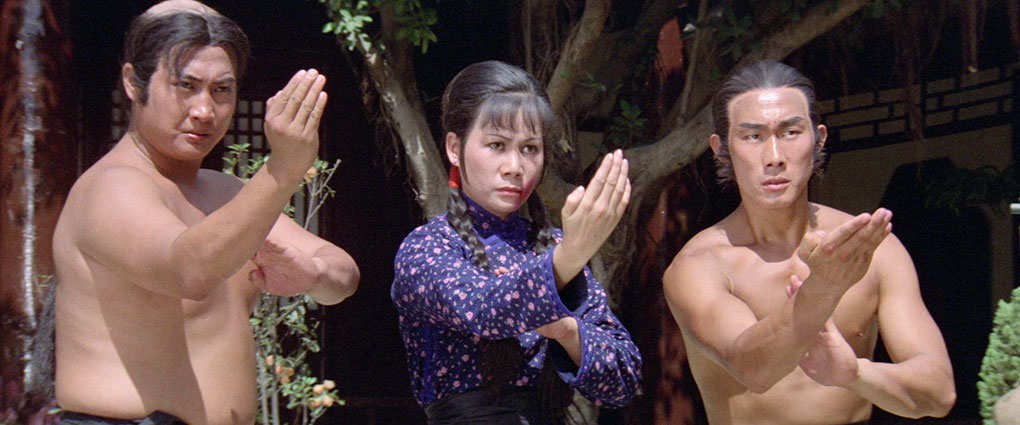
Warriors Two is an absolute belter of a martial arts movie, one whose brilliantly choregraphed and furiously performed kung fu battles are solidly supported by well-defined characters and a more substantial narrative than the genre norm. The comedy is generally well integrated into the action, adding a light-hearted element that makes the story’s occasional dark turns all the more effective, and it's always refreshing to watch a martial arts movie whose director understands how kung fu fighting should be filmed and edited to best showcase the considerable skills of his performers. It’s no surprise that it’s regarded as a genre classic, and one of the pre-Ip Man Wing Chun movies, the other being…
| THE PRODIGAL SON [BAAI GA JAI] (1981) |
|
Young Leung Tsan (Yuen Biao) has a bit of a reputation, being so skilled at martial arts that he soundly beats anyone dumb enough to challenge him, which doesn’t stop those looking to make a name for themselves from trying to take him on. No sooner has he sat down in a tea house with his loyal retainer Yee Tung-Choi (Peter Chan Lung, who plays the role with what looks like two gobstoppers jammed into his lower cheeks) than he’s spotted by a trio of troublemakers, one of whom launches a hopeless attack by attempting to leap from his balcony to Tsan’s and plummeting to the ground below instead. His companions throw themselves at Tsan instead and are soundly beaten for their trouble, and when the instigator of the fight comes to, his second attack on Tsan goes as badly as the first. Tsan, his reputation as a top-flight brawler intact, pays for the damage and leaves, but unbeknown to him, the injured first attacker is met by Yee and paid a fee for his trouble, one that he complains won’t even cover his medical bills. It turns out that Tsan is not as skilled in martial arts as he believes, and his opponents are being paid by his wealthy father (Chan Yau-hau) to challenge him and lose. It’s a deception designed to send a message out to others that his son and sole heir is not someone to be messed with, thereby protecting him from genuine assault. His reputation has earned Tsan the nickname of Street Fighter. Those who have realised the whole thing is a sham have taken to calling him Street Briber instead.
That evening, a friend of Tsan’s named Master Man (Wellson Chin) attends the travelling Lok Fung Nin opera with his two retainers, and is so entranced by its leading lady that he goes backstage afterwards to try and chat her up, blissfully unaware that she is actually male performer Leung Yee-Tai (Lam Ching-Ying). When the amused but still in-character Leung casually rejects Man’s advances, Man loses his rag and is taught a sound lesson by the far higher skilled Leung, who uses the ensuing one-sided fight to paint clown makeup on the hapless Man’s face. Outraged that his friend should be so publicly humiliated, the following day Tsan marches into the opera house and demands to see Leung, clearly intending to teach him a lesson. Leung is unimpressed, and on hearing Tsan’s name reveals to him the very secret his friends and teachers have gone to so much trouble to conceal for so long, and even refers to him by his unofficial nickname of Street Briber. The outraged Tsan attacks, but Leung easily outmanoeuvres him, embarrassing him further by doing so whilst behaving in a feminine manner and mocking him in song. A short fight later, the beaten Tsan demands to know the truth, and Leung his happy to explain it. “Your kung fu doesn’t even have a basic foundation,” he tells him. “Anyone who’s ever truly learnt kung fu could defeat you.”
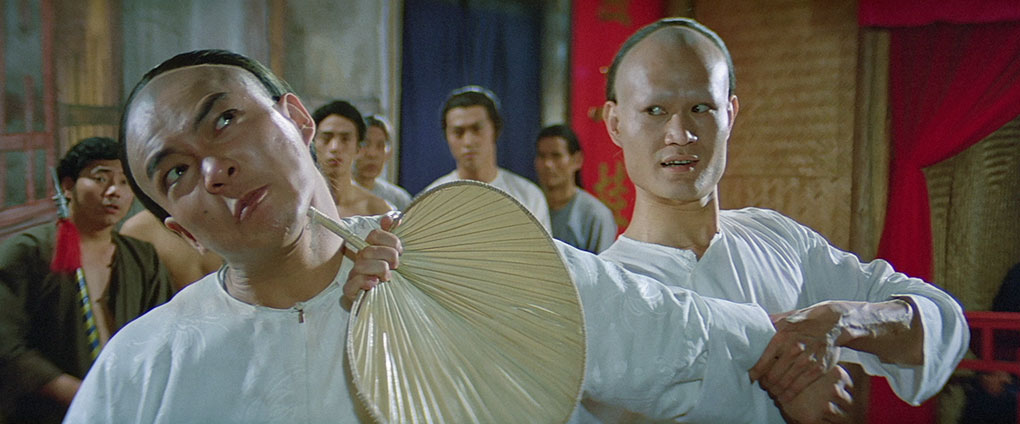
Further evidence of Tsan’s substandard skills comes a short while later when he confronts the two teachers whom he regularly beats (Chin Yuet-Sang and Lee Hoi-Sang) and threatens to fire them if they fail to defeat him this time, and figuring they’re going to lose their jobs either way, they really let him have it. When Tsan’s father realises that his son now knows the truth, he attempts to bribe Leung into accepting his son as an apprentice, but Leung is not remotely interested in taking the boy on. Tsan is not to be so easily dissuaded, and when the Lok Fung Nin opera shuts its doors and heads to the capital city, Leung is startled to discover that Tsan has joined the troupe as a stuntman and his personal assistant, a position he effectively had bought for him by his moneybags father, who has since purchased the Lok Fung Nin company. Depressingly, nothing much has changed on that front. Later, when the philandering of troupe actor Au Yuk-Gwai (Wei Pai) forces him to flee the angry husband of his latest affair, Tsan is unexpectedly asked to play the key role of the heavily made-up Lord Guan, which sees him mistaken for the Au when the husband and his cronies turn up during a performance to take revenge. The resulting fight eventually spills onto the stage and is brought to a quick halt by Leung, who so impresses the watching Nifei (Frankie Chan Fan-Kei), a skilled fighter who is constantly looking to improve his kung fu, that he becomes determined to challenge and defeat this most impressive of opponents.
Even a quick glance at the above setup summary should give an idea of just how much busier the narrative of The Prodigal Son is than the genre norm. It’s also more blatantly comedic than its predecessor, the opening tea room battle boasting the sort of deftly executed blend of clowning, furious action and wincingly painful-looking stunts with which Jackie Chan was already starting to make his name. This action-comedy continues in the face-painting fight at the opera, and again in the mistaken identity assault on Tsan, where opera tradition forbids him speaking while wearing the Lord Guan makeup, which prevents him from alerting his attackers to the fact that they have the wrong man. It sets the tone that is maintained for the first 45 minutes, and only shows signs of taking a more serious turn when a test-of-skills fight between Leung and Nifei is brought to a premature halt by a resurgence of the former’s crippling asthma, an interesting and unusual twist for a film of its type and day (nowadays, as soon as you learn that a character has asthma, you just know that sooner or later there will be a scene built around the sudden and urgent need for an inhaler).
And then it happens. I’m not about to reveal exactly what, but after 45 minutes of comedy-laced action, we’re hit a scene so dark and so violent – as much in its implication as its content – that I was genuinely startled. It climaxes in one of the film’s most spectacular images involving a giant burning flag that is being swung as a weapon, during which a balls-of-steel stuntman takes a dive through a raging wall of fire. Then, just as I was coming to terms with the grimly serious new direction that the film seemed to have taken, the story is effectively paused to introduce the characters of portly Wong Wah-Bo (Sammo Hung) and his sarcastically named daughter Skinny (Ho Wai-han) in what is effectively an extended comedy skit. It’s not that Wong’s calligraphic acrobatics aren’t funny or inventively staged, because they are, it’s just coming straight after that scene, it triggered the second stark tonal shift for the film in the space of just ten minutes. What next, I wondered, a musical number?

Yet coming back to the film a second and third time, where these shifts of tone are stripped of the shock of the new, I found myself admiring how Sammo so effectively misdirects us in order to jolt us harder with the first of these shifts, and the boldly outrageous cheek he displays by immediately following it with such an openly comical scene of character introduction. And these new characters do quickly prove relevant to what then unfolds. It turns out that Leung is Wong’s brother and he and Tsan have fled to Wong’s isolated home to recover from ill health and injury, and in no time at all the blend of action and comedy from the early scenes is making a comeback. Leung finally agrees to accept Tsan as his apprentice and to train him, then a short while later suggests that he’d learn more from Wong, which allows Leung to take it easy while his brother does the hard work. Hung the director gets plenty of comic mileage from these superbly staged and performed training scenes, and while Skinny is the target of a few too many jokes about her body and her ample frame, they are made palatable by Ho Wai-han’s easy likeability and her way with low-key comic timing. It all builds to the expected final fight between the newly-trained Tsan and the still-determined Nifei, whose desire to fight against the best to test his skills is somewhat more honourable than the blatantly evil motivations of the usual martial arts movie foe.
Despite being given a couple of jolts by those sudden tonal shifts the first time around, subsequent viewings have helped me to appreciate The Prodigal Son for the considerable achievement that it is. The displays of the Wing Chun fighting style are even tighter this time around, and if the camera undercranking has here resulted in footage whose speed is more visibly accelerated (there are moments when serious fight moves come close to looking comic as a result), the sheer dexterity and precision of the performers makes every fight, every training sequence, and every bit of physical comedy a mesmerising watch. It’s more skewed towards comedy kung fu than its predecessor – complete with wacky music cues, innuendoes and toilet humour – but when the action comes, it’s genuinely dazzling. As the second film in a thematically linked double-bill, it’s once again up there with Hung’s best movies and the finest that the genre has to offer.
| the two cuts of Warriors Two |
|
Two versions of Warriors Two have been included on the same disc in this set, the original Hong Kong version and the Export version, which is five minutes shorter than the Hong Kong original. Normally, I’d expect some explanation of the difference between the two and why shots or sequences were cut, but unless I’m missing something I found nothing here, on the disc, in the accompanying booklet, or in the special features. I was going to just let it ride as other reviews seem to have, but curiosity got the better of me, so I put both versions side-by-side on the editing bench to identify what the differences are. To my surprise, they have nothing to do with the violence and bloodshed, but consist solely of character scenes and small trims to sequences, some of which I found genuinely bemusing. Here’s a list of the sequences and shots that have been cut for in export version and their running times, which I may well post later on the film’s IMDb page. Note that there are some spoilers here, so I’d save this for after watching the original Hong Kong cut, which, as the more complete version, should be the default one to watch.
- The whole sequence in which the two conmen trick Fat Chun out of his wares at the market in the opening scene has gone. (3:02)
- Fat Chun’s conversation at the bank with Change-Giver Wah about work woes has been cut, as has his encounter that immediately follows with one of the conmen whilst carrying buckets of effluence. (1:00)
- In the scene where Fat Chun learns the fate of Change-Giver Wah’s mother, a single shot of Chun watching Thunder Tai and Manchu Chiu nodding conspiratorially at each other has been lifted. (0:09)
- Part of the shot when Change-Giver Wah is questioning Fat Chun about his mother has been cut, specifically when Wah asks Chun if he saw anyone else while he was out and Chun reveals that he saw the mayor, but only in passing. (1:11)
- Immediately after Leung Tsan has refused to accept Change-Giver Wah as an apprentice, a short sequence in which Tsan walks in and sits down for a meal with Fat Chun, Gam Fung and an apprentice named Three-Horned Beetle has been removed. In it, Chun asks Tsan about Wah and gets no reply, then signals his companions to do likewise – Gam Fung is cut short by Tsan, and Three-Horned Beetle elects to keep his mouth shut. (0:49)
- When Change-Giver Wah’s training begins and Tsan is demonstrating Wing Chun moves, a single shot of Fat Chun explaining to Wah the meaning of the ‘Little Ideas’ form of Wing Chun has been snipped. (0:18)
Both films have clearly undergone careful restoration and the results are spectacular. In daylight exterior scenes, they both belie their age and the belief of Hong Kong film companies of the day that these movies had no shelf life beyond the initial cinema release and were thus disposable commodities. Framed in their original scope ratio of 2.40:1, at their best, notably during daylight exterior scenes, the images on both discs are glorious, with a beautifully balanced contrast range, crisply defined detail and vibrant colour. Black levels are solid in these scenes, but do soften just a tad in some interior sequences, just occasionally on a shot-to shot basis (the key fight in which the animal trap is used is a good example), suggesting more than one source was used for the restorations. For the most part, though, both transfers look terrific, and are also clean of any blemishes and jitter whilst retaining a fine organic film grain.
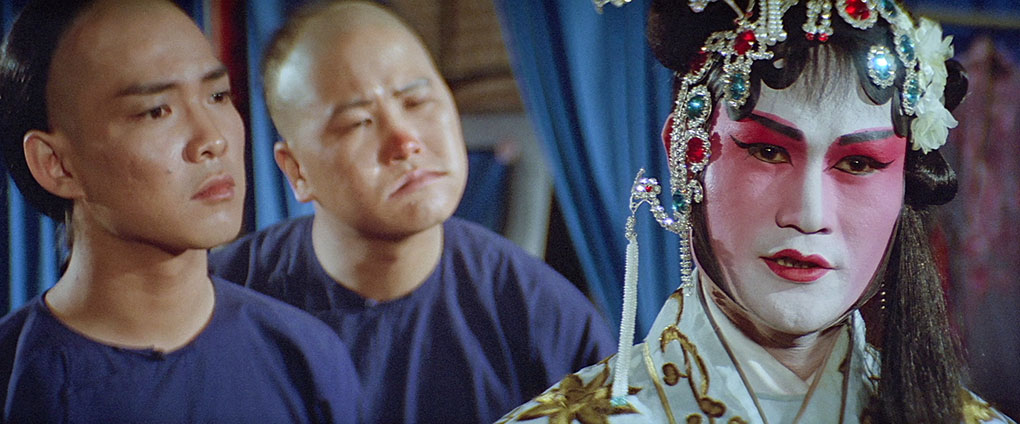
Both films have two soundtrack options in the shape of the original Cantonese dub and the English dub used for the international release. Obviously, with the actors also speaking Cantonese (these films were shot silent and the soundtracks added in post-production), the Cantonese track is always going to be the better fit than the peculiar mixture of English and American accents on the English dub, where the words being spoken are clearly not coming from the mouths of the performers.
Sonically, none of the tracks is going to win any prizes, all displaying a narrow dynamic range but with subtle differences. On Warriors Two, the Cantonese dialogue has a tinny treble feel, but the music fares a little better and the thumps and wooshes of combat have a touch more bass than I was expecting. It’s a similar story for the English track, but this is saddled with a low level background hum and a little crackle in places. It’s worth noting that the Export Version of the film has only the English dub, and that the English track on the Hong Kong Version switches to Cantonese with English subtitles during the short sequences detailed above for which no English language track has been found.
On The Prodigal Son, the Cantonese track is similarly narrow in range, but has lost a little of the treble of the Warriors Two track without gaining anything in exchange at the bass end. Dialogue and music are still clear, however, and the combat effects have the appropriate wallop. The English track on this film has a touch more clarity on the trebles but is otherwise similar to the Cantonese track and clear of any obvious signs of wear or damage.
WARRIORS TWO
Audio Commentary on Hong Kong Version by Frank Djeng and Bobby Samuels
For the first of two commentaries on Warriors Two, martial arts movie expert Frank Djeng is joined by Bobby Samuels, who had the distinction of being the only African American martial artist working in Hong Kong kung fu cinema during its golden age. This gives him an insider’s view of the industry in the 70s and 80s, something Djeng is keen to know the details of and that Samuels is happy to share. And this is worth hearing, as his journey from a starry-eyed kid watching King Boxer (also my first martial arts movie, as it happens) to teaching himself Cantonese, moving to Hong Kong, meeting Sammo Hung and living at his house, being accepted by the local community, and working in martial arts cinema is a consistently interesting one. He was even in the editing room with John Woo when he was cutting his breakthrough film, A Better Tomorrow. The two men also talk about Warriors Two, commenting on the fighting styles and techniques, the training sequence and the information on Wing Chun that is imparted, Sammo’s focus on character, his insertion of comic moments where you would not expect them, the tragic turns that the film takes, his seamless transition between two simultaneously fought fights (it’s so seamless, in fact, that it hadn’t occurred to me until it was pointed out here), and plenty more. Great stuff. My only small gripe is that any time the two briefly pause, the film sound is raised to a higher volume than that of the commentary, which had me quickly reaching for the volume control to turn the sound down, only to then have to raise it again when the commentary restarted a few seconds later.

Audio Commentary of Export Version by Mike Leeder and Arne Venema
Commenting on the Export Version – but not on the differences between this and the original Hong Kong edit – is the ever-lively duo of actor, producer and martial arts film expert ‘Big Mike’ Leeder, and filmmaker and film historian Arne Venema. As on their previous collaborations, most notably their four commentaries on Eureka’s Cinematic Vengeance: 8 Kung Fu Classic by Jospeh Kuo box set, Leeder and Venema appear to be having the time of their lives and barely pause for breath in their appreciation and analysis of what they both regard as a genre classic. Once again, Leeder has plenty of anecdotes about working in the Hong Kong movie industry and with some of those involved in this production, but he and Venema also have plenty to say about the film itself, with discussion on the locations, the performers, writer, director and actor Sammo Hung, editor Peter Cheung, the genre trope of tea houses being a location for conflict, the Wing Chun fighting style, the horror-tinged night-time bamboo forest fight, and a whole load more. It’s fascinating stuff, and impressively there’s almost no serious crossover with the other commentary, fully justifying the inclusion of both. No problems with audio levels here, as the two don’t stop talking long enough for the film sound volume to be raised.
Making of Warriors Two: Archival Featurette (47:31)
An archival documentary made for a previous Hong Kong Legends release of the film and hosted by genre expert and one-time HKL commentary superstar, Bey Logan. It’s built around interviews with actors Leung Kar-yan, Fong Hak-on and Casanova Wong, screenwriter, director and performer Sammo Hung, and Wing Chun expert Sifu Guy Lai, most of whom converse in their native languages (Wong is Korean, the others Chinese), with translation provided by fixed English subtitles. Many aspects of the filming are discussed, including Lai’s training of the performers in Wing Chun, the high standards Sammo has and expects from his collaborators, the real historical figure on whom the character of Leung Tsan is based, the downhill slide of the Hong Kong film industry since the martial arts golden age, and much more. Both Wong and Fong talk about the extraordinary late film 360 degree flying kick executed by Wong that left Fong struggling to breathe after the first take, and Leung recalls how hard the wooden dummy fight scene was, and how much it hurt to have his foot wedged in even a particularly nasty prop.
Stills Gallery
15 screens of production stills, posters, lobby cards and campaign book pages.
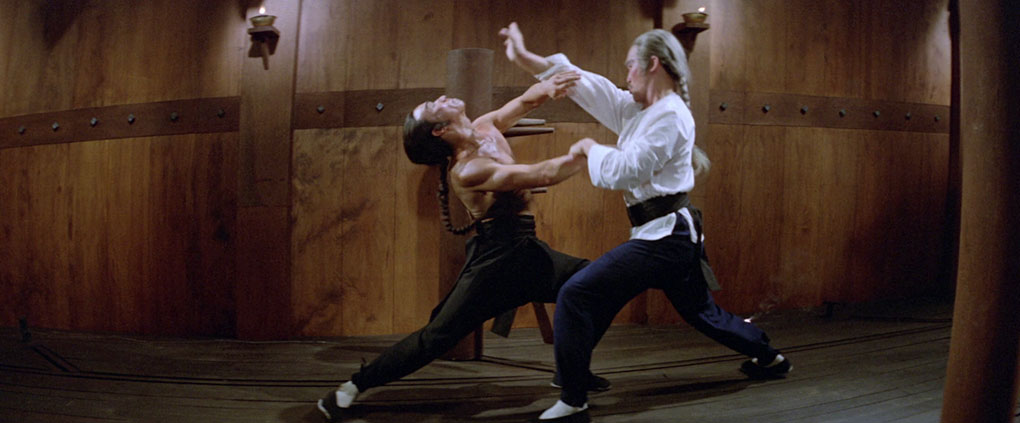
Original Theatrical Trailer (4:00)
A solid-enough sell that showcases the training scenes before moving exclusively onto fight sequence footage, including material from the climactic bout. It celebrates the film’s stars and the internationality of its cast, and particularly the bringing of Wing Chun to a wider audience, which is described entertainingly here as, “a serious introduction to the national sport to flaunt abroad.”
International Trailer (3:29)
Training and fight sequences are intercut with plot details that are so briefly outlined that they fail to really register in a sell that feels cheesier than the above thanks to the English dub. Those who know the actors may be surprised at the spelling of their on-screen names here.
THE PRODIGAL SON
Audio Commentary by Frank Djeng and Bobby Samuels
Djeng and Samuels are back with another busy commentary crammed with information of the film, its performers and creators, together with opinions and observations on individual sequences and the film as a whole. Subjects covered include the Peking Opera training and the reason why female characters were played by men, the kung fu balls that Frankie Chan is seen manipulating in the film, the absence of a single true villain, the actors, the camerawork, the fighting techniques, and much more. Samuels notes early on that the film is more ‘cranked’ than is predecessor and recalls how much it hurt being punched by Yuen Biao, while Djeng once again provides welcome translations of Chinese terms and wordplay. Both salute the casting and comic performance of Ho Wai-han as Skinny and the work of the stunt men, fight choreographers and martial artists. As before, Samuels is the source of some interesting anecdotes from his time living and working in Hong Kong, the most mouth-watering of which sees him recall going through Sammo’s VHS tapes and finding never-released footage from Enter the Dragon (Sammo plays the apprentice monk whom Bruce Lee fights in his first scene). Another fine commentary, but once again I wondered why it was felt necessary to bring the film sound up to an abrasively higher volume every time there’s even a small pause.

Audio Commentary by Mike Leeder and Arne Venema
As before, Leeder and Venema deliver an energetic and pause-free commentary on a film they both hold in very high regard and describe as “one of the ultimate Wing Chun movies,” even if they admit in the previous commentary to slightly preferring its more streamlined predecessor. They provide a considerable amount of information on the performers, on the Peking Opera, on Wing Chun and its various strands and origin stories, and particularly on writer-director-actor Sammo Hung and leading man Yuen Biao, as well as detailing how Wong Kar-wai’s plans to make the first Yip Man movie stumbled and eventually resulted in the 2013 The Grandmaster. As before, Leeder shares fascinating tales of his time working on martial arts movies, and as long time Hong Kong residents, both men share information on the city and its culture that I, for one, found revealing and interesting, including the fact that Peking Operas are still performed today in quickly erected and dismantled temporary bamboo theatres. I was particularly amused to learn that a couple of years ago there was even an opera about Donald Trump. No specifics were provided on the content, but a quick description of the lead character suggests it was likely less than flattering.
Wing Chun 101 (29:59)
A newly filmed featurette hosted by Frank Djeng (how nice it is to be able to put a face to a by-now familiar voice), in which he talks to Wing Chun Sifu Alex Richter in his New York school. The highly affable Richter takes us on a tour of his two-floor studio, in which he has a handful of precious items, including one of the original wooden dummies made by the craftsman who made them for Yip Man, a framed photo of Yip Man and Bruce Lee practising Wing Chun, and an original movie poster for Warriors Two. He also demonstrates the movement techniques learned by beginners and some advanced defence moves with what I presume is a colleague or high-level student. The camerawork is a bit loose during the conversations (way too much headroom), but the framing improves when it really matters during the demonstration sequences.
The Heroic Trio (28:01)
An archive featurette, sourced from the 2011 Hong Kong Legends Special Collector’s Edition DVD release of the film, built around interviews with Sammo Hung, Yuen Biao, and Frankie Chan. Sammo talks about deciding to use Wing Chun in the film, the philosophy of kung fu, choreographing action, lead players Yuen Biao and Lam Ching-Ying, shooting the fire sequence, looking to do something new with every film, and the meaning of the film’s ending. Biao covers learning various martial arts, why you can’t use Peking Opera moves in a film, doubling for Frankie Chan in a climactic fight in which he was effectively battling himself at times, and having to film around the fakery of Chan’s head injury makeup in the finale. Chan talks about working with Biao (“he never gets angry”), how long the fight sequences took to film, his favourite scene, and having to deal with the pain in his arms from so much contact fighting. Chan also puts the success of the film down to Sammo’s hard work, but is surprised so many people still watch and admire it.
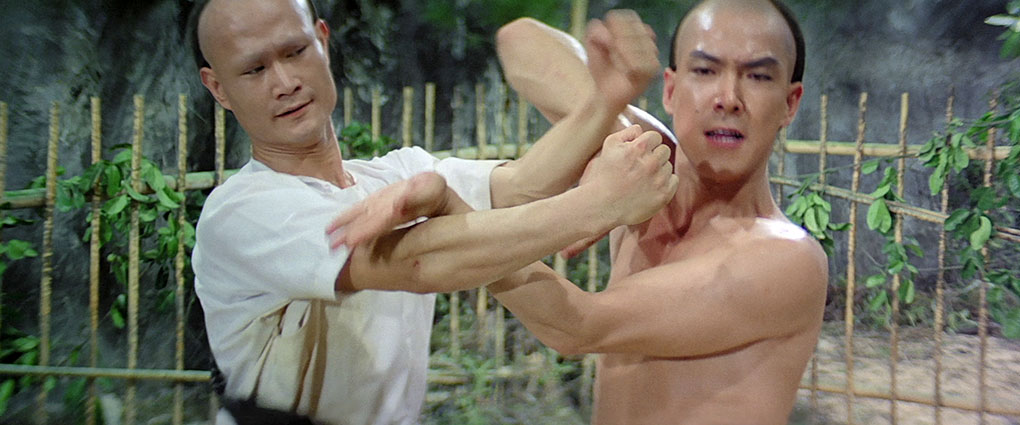
Interview with Guy Lai (28:40)
An archival interview with Wing Chun Sifu Guy Lai, with Wing Chun demonstrations by Sifu Austin Goh, which has also been sourced from the earlier Hong Kong Legends DVD. Lai explains how he first came to this particular martial art, provides some detail on its technique and main components, and talks about teenage years spent in the company of an older Bruce Lee, whom he believes took Wing Chun to a higher level with Jeet Kune Do. He also discusses his work on the film, working with Sammo Hung, training the actors (Yuen Biao was easy to teach, he assures us), and helping to devise ways to make this relatively uncinematic martial art look good on screen. Small extracts from this interview also appear in the Making of Warriors Two featurette on the companion disc.
Alternate English Credits (1:44)
As it says in the title, the opening and closing credits for what I presume was the version released in the British and American market. That text looks almost pristine enough to have been added digitally…
Stills Gallery
24 screens of production stills and Hong Kong lobby cards.
Original Theatrical Trailer (4:27)
A busy trailer with a cocky narrator, one that outlines most of the plot and unsurprisingly includes footage from many of the prime action scenes, including a spectacular tumble at the climax. Narrator Boy also assures us that, “To make this film director Sammo Hung strained heart and lungs coming up with scenes.” Blimey.
International Trailer (2:13)
A cut down version of the above with dubbed English dialogue, a jaunty American narrator, and a daffily comic music score that takes a serious turn about halfway through.
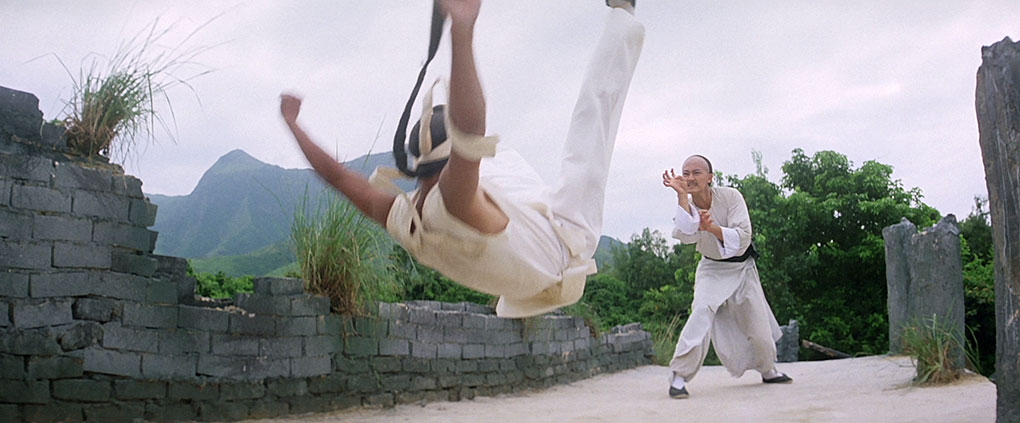
US Home Video Trailer (1:46)
A dramatic male voice tells us about this new remastered widescreen transfer of the film, which was created for the American Tai Seng release. Does the job, though I’m not sure about their choice of backing music.
PLUS
Finally, the usual Eureka Bookletis divided into two halves, the first being devoted to Warriors Two, the second to The Prodigal Son. Each opens with the credits for the film, from which I’ve sourced the spelling of character names (these seem to vary, depending on the source), which are followed by excellent essays on the films by critic, historian and filmmaker James Oliver. In the first, he salutes the action, comic elements and filmmaking of the earlier movie, and in the second, the cinematic maturity and action choreography of the later one. Also included are the liner notes from the US laserdisc release of The Prodigal Son, written by Frank Djeng.
Two belting martial arts movies directed by and co-starring Sammo Hung, each beautifully restored and accompanied by two terrific commentaries apiece, some fine imported supplemental features, and a new one shot especially for this release, all of which make this an absolute must-have for martial arts and action movie devotees. If I was forced to choose a favourite, I would probably side with Mike Leeder and Arne Venema and go with Warriors Two for its blistering (and less obviously undercranked) martial arts choreography and spectacular action, as well as its tighter storytelling economy. That said, there’s so much going on in The Prodigal Son, and so many extraordinary moments and dynamite fight scenes that I’ll probably end up swapping my allegiance back and force over the coming years. Just as well I have them both then. Very highly recommended.
|